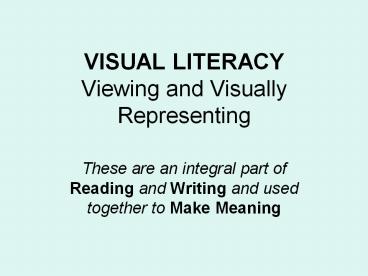VISUAL LITERACY Viewing and Visually Representing - PowerPoint PPT Presentation
1 / 11
Title:
VISUAL LITERACY Viewing and Visually Representing
Description:
Hue: colour: warm and cool. Saturation: amount of grey in a particular colour ... compelling visual images, paintings, posters, graphics in subject areas to teach ... – PowerPoint PPT presentation
Number of Views:252
Avg rating:3.0/5.0
Title: VISUAL LITERACY Viewing and Visually Representing
1
VISUAL LITERACYViewing and Visually Representing
- These are an integral part of Reading and Writing
and used together to Make Meaning
2
Reading and viewing
Thinking
Thinking
Making Meaning
Talking and listening
Writing and representing
Thinking
3
Visual Literacy
- Is the ability to see, understand, think, create
and communicate graphically. - Visual Literacy is learned, just like reading and
writing are learned. - Basic skills involve identification of the
subject or elements in the image. - Higher level skills require critical thinking to
read visual texts e.g., graphs, diagrams and maps
4
Basic Elements of Visual Communication
- Dot pointer or marker of space
- Line Show motion or direction
- Shape outline of objects/negative spaces
- Direction the way the viewers eye moves
- Texture the feel of an objects surface
- Hue colour warm and cool
- Saturation amount of grey in a particular
colour - Value tone, light and dark in contrast
- Scale relative size of objects
- Dimension use of linear perspective
- Motion implied using blurring, line, shape,
texture or direction
5
Key Elements of Visual Art and Concept Design
- Lighting and Colour use of light and colour to
create mood or feelings, or show change in mood
or time - Sound presence or absence of sound to create a
mood, convey action, or signal change - Composition arrangement of masses and spaces
objects, people, and places within a scene or
screen - Form three-dimensional quality as in height,
width and depth. - Perspective Illusion of distance and point of
view created by size, overlapping, atmosphere,
sharpness or blurriness, angles
6
The Viewing Process
- Visual images convey ideas, beliefs, and values.
- Viewing is an active process of constructing
meaning. - Attention to and comprehension of visual
information broadens the ways students learn. - Viewing involves 3 steps receiving, attending
and assigning meaning.
7
Step 1 The viewer RECEIVES the visual
stimuli. Step 2 The viewer ATTENDS to the
attributes of the stimuli such as colour and
shape. Attributes and context contribute to the
viewers interpretation. Step 3 The viewer
ASSIGNS MEANING to a visual image based on
previous experience and prior knowledge.
8
Teaching Viewing Strategies
- View a video BEFORE, DURING or AFTER reading
- Compare book and video versions of a story
- Use compelling visual images, paintings, posters,
graphics in subject areas to teach (model and
share) the basic visual elements - Model and share the key elements of Visual Art
and Design when using paintings, posters and
graphics - Use viewing projects that help students learn to
comprehend visual information
9
Viewing Projects
- View a television, film, CD-ROM, or video version
of a book - Compare illustrations in several versions of the
same book - Analyze the illustrators craft to discover
techniques used. - View primary sources to extract information about
a subject topic or theme. - View the work of one illustrator in several books
10
Guidelines for Using Visual Media
- Preview
- Plan how to use
- Set the purpose
- Use the pause function
- Re-view
- Vary the procedure used
- Compare the authors and cameras view
- Provide opportunities for response
11
- With a partner
- View the poster to identify basic visual elements
that are present. - Identify the key elements of visual art and
design used to communicate messages. - Join another group and share your learning using
your posters. - Discuss how you might use the posters in your
class to teach viewing skills as part of a
subject area lesson. - Share ideas in the large group.































